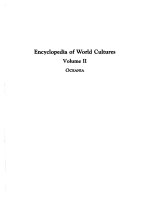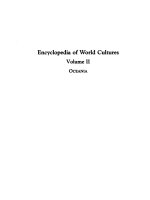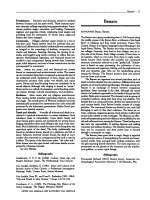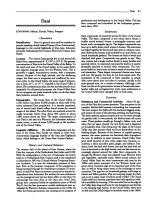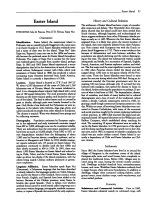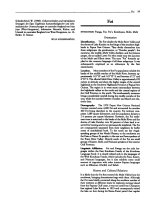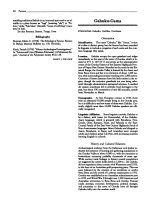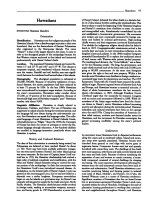Encyclopedia of World Cultures Volume III - South Asia - H pps
Bạn đang xem bản rút gọn của tài liệu. Xem và tải ngay bản đầy đủ của tài liệu tại đây (849.55 KB, 7 trang )
Greece,
whose
devotees
also
dressed
in
women's
clothing
and
sometimes
castrated
themselves.
ETHNONYM:
Eunuch
Orientation
Identification.
Hijras
are
a
social
group,
part
religious
cult
and
part
caste,
who
live
mainly
in
north
India.
They
are
cul-
turally
defined
either
as
"neither
men
nor
women"
or
as
men
who
become
women
by
adopting
women's
dress
and
behav-
ior.
Hijras
are
devotees
of
Buhuchara
Mata,
a
version
of
the
Indian
mother
goddess.
Through
their
identification
with
the
goddess,
ratified
by
an
emasculation
ritual,
hijras
are
believed
to
be
vehicles
of
the
goddess's
power.
Although
culturally
de-
fined
as
celibate,
hijras
do
engage
in
widespread
prostitution
in
which
their
sexual-erotic
role
is
as
women
with
men.
Their
traditional
way
of
earning
a
living
is
by
collecting
alms,
receiv-
ing
payments
for
blessing
newborn
males,
and
serving
at
the
temple
of
their
goddess.
Hijras
are
generally
called
eunuchs,
and
sexual
impotence
is
central
to
the
definition
of
a
hijra
and
a
major
criterion
for
initiation
into
the
group.
Location.
Most
hijras
live
in
the
cities
of
north
India,
where
they
have
more
opportunities
to
engage
in
their
tradi-
tional
occupations.
Hijras
are
also
found
in
rural
areas
in
the
north,
as
well
as
cities
in
south
India
where
they
work
mainly
as
prostitutes.
Demography.
The
census
of
India
does
not
list
hijras
sep-
arately;
they
are
usually
counted
as
men,
but
upon
request
they
may
be
counted
as
women.
It
is
thus
impossible
to
say
with
certainty
how
many
hijras
there
are
in
India.
Large
cities
like
Bombay
or
Delhi
may
have
5,000
hijras
living
in
twenty
or
thirty
localities;
the
national
estimate
may
be
as
high
as
50,000.
Linguistic
Affiliation.
Hijras
speak
the
language
of
the
re-
gions
of
India
in
which
they
were
born
and
lived
before
join-
ing
the
community.
There
is
no
separate
hijra
language,
al-
though
there
is
a
feminized
intonation
and
use
of
slang
that
characterizes
their
talk.
Hijras
come
from
all
over
India
and
those
from
south
India
who
move
to
the
north
learn
Hindi
as
well
as
the
regional
languages.
History
and
Cultural
Relations
The
history
and
cultural
relations
of
the
hijras
are
rooted
both
in
ancient
Hinduism,
where
eunuchs
are
mentioned
in
a
variety
of
texts,
including
the
epic
Mahabharata,
and
in
Islam,
where
eunuchs
served
in
the
harems
of
the
Mogul
rulers.
The
ritual
participation
of
hijras
in
life-cycle
ceremonies
has
a
clearly
Hindu
origin,
though
they
may
perform
for
Muslims
as
well.
Many
aspects
of
hijra
social
organization
are
taken
from
Islam,
and
many
of
the
most
important
hijra
leaders
have
been
and
are
Muslim.
However,
hijras
differ
from
traditional
Muslim
eunuchs,
who
did
not
dress
as
women
and
were
sexu-
ally
inactive.
Nor
were
Muslim
court
eunuchs
endowed
with
the
powers
to
bless
and
to
curse
that
hijras
derive
from
their
ambiguous
sexuality
and
connection
with
the
mother
god-
dess.
In
the
eighteenth
and
nineteenth
centuries
Hindu
and
Muslim
hijras
did
not
live
together,
but
in
contemporary
India
they
often
do.
Another
historical
connection
of
the
hijras
appears
to
be
with
the
Magna
Mata
cults
in
ancient
Economy
Like
every
caste
in
India,
hijras
are
primarily
associated
with
a
few
traditional
occupations,
foremost
among
them
being
ritua-
lized
performances
at
childbirth
and
marriage.
The
hijras'
per-
formance
consists
of
dancing
and
singing,
accompanied
by
a
two-sided
drum,
and
the
blessing
of
the
child
or
the
married
couple
in
the
name
of
the
mother
goddess.
In
return
for
these
blessings
the
hijras
receive
badhai,
traditional
gifts
in
cash
and
goods,
always
including
some
sweets,
cloth,
and
grains.
Hijras
also
beg
in
the
streets
for
alms
from
passersby
and
from
shops;
these
activities
are
regulated
on
a
daily
rotational
basis
by
the
elders
of
the
hijra
community.
Although
prostitution
is
consid-
ered
deviant
within
the
hijra
community,
as
it
is
in
India
gener-
ally,
many
hijras
earn
a
living
from
it.
Prostitution
is
carried
out
within
a
hijra
household,
under
the
supervision
of
a
house
manager
or
"madam,"
who
will
collect
part
or
all
of the
prostitute's
earnings
in
return
for
shelter,
food,
a
small
allow-
ance,
and
protection
from
the
police
and
rowdy
customers.
Al-
though
many
young
hijra
prostitutes
feel
that
they
are
ex-
ploited
by
their
"madams,"
few
live
or
work
on
their
own.
Because
of
their
historical
role
as
performers,
hijras
sometimes
dance
in
nonritual
roles,
such
as
at
stag
parties,
for
college
functions,
or
in
films.
A
small
number
of
hijras
also
serve
the
goddess
Bahuchara
at
her
major
temple
in
Gujarat,
blessing
visitors
to
the
temple
and
telling
them
the
stories
of
the
god-
dess
in
exchange
for
a
few
coins.
Hijras
can
also
be found
as
household
servants
and
cooks,
and
in
some
cities
in
India
they
run
public
bathhouses.
Hijras
complain
that
in
contemporary
India
their
opportunity
to
earn
a
living
by
the
respectable
means
of
performing
at
marriages
and
births
has
declined,
due
to
smaller
families,
less
elaborate
life-cycle
ceremonies,
and
a
general
decline
in
the
respect
for
traditional
ritual
specialists.
Hijras
have
effectively
maintained
economic
predominance,
if
not
total
monopoly,
over
their
ritual
role.
Defined
by
the
larger
society
as
emasculated
men,
they
have
clearly
seen
that
it
is
in
their
interest
to
preserve
this
definition
of
their
role.
They
do
this
by
making
loud
and
public
gestures
to
denounce
the
"frauds"
and
"fakes"
who
imitate
them.
They
thus
reinforce
in
the
public
mind
their
own
sole
right
to
their
traditional
occu-
pations.
When
hijras
find
other
female
impersonators
attempt-
ing
to
perform
where
it
is
their
right
to
do
so,
they
chase
them
away,
using
physical
force
if
necessary.
Hijra
claims
to
exclusive
entitlement
to
perform
at
life-cycle
rituals,
to
collect
alms
in
certain
territories,
and
even
to
own
land
communally
receive
historical
support
in
the
edicts
of
some
Indian
states
that
offi-
cially
granted
them
these
rights.
Hijras
have
also
been
successful
in
controlling
their
audi-
ences
in
their
own
economic
interest.
Hijras
identify
with
re-
nouncers
(sannyasis)
and,
like
them,
hijras
have
abandoned
their
family
and
caste
identities
in
order
to
join
their
religious
community.
Like
sannyasis,
then,
hijras
transcend
networks
of
social
obligation.
They
occupy
the
lowest
end
of
the
Indian
social
hierarchy
and,
having
no
ordinary
social
position
to
maintain
within
that
hierarchy,
hijras
are
freed
from
the
re-
straints
of
ordinary
behavior.
They
know
that
their
shame-
lessness
makes
ordinary
people
reluctant
to
provoke
them
or
to
resist
their
demands
for
money
and
hence
they
trade
on
the
fear
and
anxiety
people
have
about
them
to
coerce
com-
96
Hijra
Hijra
Hijra
97
pliance.
A
culturally
widespread
belief
in
India
is
that
hijras
have
the
power
to
curse
people
with
sterility
and bad
fortune,
most
dramatically
by
lifting
their
skirts
and
exposing
their
mutilated
genitals.
The
fear
and
anxiety
this
belief
provokes
are
sufficient
to
compel
most
people
to
give
in
to
their
de-
mands
or
at
least
to
negotiate
with
them.
Kinship
and
Social
Organization
Kinship
and
Descent.
The
major
principle
of
social
organi-
zation
among
the
hijras
is
the
relation
between
gurus
(teach-
ers)
and
their
chelas
(disciples).
This
relationship
is
modeled
both
on
the
Hindu
joint
family
and
on
the
relationship
of
spir-
itual
leader
and
disciple
in
Hinduism.
The
guru
or
senior
per-
son
in
the
relationship
is
alternately
conceived of
as
a
father,
a
mother,
or a
husband,
while
the
chela
is
regarded
as
a
depen-
dent.
The
guru,
like
an
elder
in
a
family,
is
expected
to
take
care
of
the
chela's
material
needs
and
the
chela
is
expected
to
show
respect
and
obedience
to
the
guru
and
give
the
guru
'her"
earnings.
Through
the
relationship
of
guru
and
chela,
the
chelas
of
a
guruare
like
sisters.
Every
hijra
joins
the
community
under
the
sponsorship
of
a
guru,
who
is
ideally
her
guru
for
life.
Hijras
express
the
view
that
a
hijra
could
no
more
live
without
a
guru
than
an
ordinary
person
could
live
without
a
mother.
Gurus
also
provide
the
umbrella
under
which
hijras
earn
a
liv-
ing,
as
economic
territories
among
hijras
all
come
under
the
control
of
a
particular
guru
and
are
off-limits
to
the
chelas
of
any
other
guru
without
explicit
permission.
Changing
gurus,
which
involves
a
small
ritual
and
an
escalating
fee,
is
possible,
though
frowned
upon.
In
addition
to
the
guru-chela
relation-
ship,
there
are
other
fictive
kinship
relations
of
which
the
guru
is
the
center
a
guru's
'sisters"
are
called
aunt,
and
guru's
guru
is
called
"grandmother"
(mother's
mother).
A
guru
passes
down
her
wealth
and
possessions
to
one
or
more
of
her
chelas,
usually
the
senior
chela.
Gurus
and
chelas
belong
to
the
same
"house,"
a
nonlocalized
symbolic
descent
group
similar
to
a
clan.
The
hijra
community
is
divided
into
approximately
seven
of
these
named
houses
(with
some
variation
according
to
re-
gion).
The
heads
of
these
houses
within
a
particular
city
or
geographical
region
form
a
council
of
elders,
or
jamat.
This
group
makes
important
decisions
for
the
community,
is
pres-
ent
at
the
initiation
of
new
members,
and
resolves
whatever
disputes
arise
within
the
community.
Hijra
houses
are
not
ranked
and
there
are
no
meaningful
cultural
or
social distinc-
tions
among
them,
but
each
house
has
its
own
origin
story
and
certain
rules
of
behavior
special
to
itself.
When
a
hijra
dies,
it
is
the
members
of
her
house
who
arrange
the
funeral.
In
addition
to
the
regional
groupings
of
hijras
there
is
also
a
loose
national
organization,
which
mainly
meets
on
the
anniversary
of
the
death
of
an
important
hijra
guru.
Domestic
Unit.
The
most
relevant
group
in
daily
life
is
the
hijra
household.
These
are
communally
organized,
and
usually
contain
five
to
fifteen
people,
under
the
direction
of
a
guru
or
house
manager.
Hijra
households
are
structured
around
a
core
of
relatively
permanent
members,
plus
visitors
or
short-term
guests,
often
hijras
from
another
city,
who
stay
for
variable
pe-
riods
of
time.
Every
hijra
in
the
household
must
contribute
to
its
economic
well-being
by
working
and
in
return
is
given
the
basic
necessities
of
life
and
perhaps
a
few
luxuries.
Older
hijras
who
are
no
longer
able
or
do
not
wish
to
work
outside
the
house
do
domestic
chores.
Members
of
a
household
may
have
different
gurus
and
belong
to
different
houses.
Social
Control.
The
hijra
community
has
developed
effec-
tive
mechanisms
of
social
control
over
its
members,
mainly
through
the
near
monopoly
hijra
elders
have
over
the
oppor-
tunities
for
work.
When
a
hijra
joins
the
community,
she
pays
a
"fee"
which
gives
her
the
right
to
earn
a
living
in
the
particu-
lar
territory
"owned"
by
her
guru.
Any
hijra
who
is
thrown
out
of
the
community
by
her
guru
forfeits
her
right
to
work
as
part
of
the
group.
Since
all
hijra
performances
are
arranged
by
a
guru,
a
hijra
without
a
guru
will
not
be
invited
to
perform,
nor
can
she
beg
for
alms
in
any
place
already
assigned
to
another
hijra
group.
A
hijra
suspended
from
the
community
may
at-
tempt
to
form
her
own
work
group,
but
this
is
difficult
as
it
re-
quires
finding
an
area
not
claimed
by
another
hijra
group.
Hijras
use
both
verbal
and
physical
abuse
to
protect
their
ter-
ritories
and
suspension
severely
inhibits
one's
ability
to
earn.
Normally,
suspension
is
the
result
only
of
severe
misbehavior,
such
as
attacking
one's
guru.
For
lesser
offenses
hijras
may
be
warned,
fined,
or
have
their
hair
cut
by
the
jamat.
The
most
important
norm
in
a
hijra
household
is
honesty
with
respect
to
property.
With
so
much
geographic
mobility
among
hijras
it
is
necessary
that
individuals
be
trustworthy.
Quarreling
and
dishonesty
are
disruptive
to
a
household
and
ultimately
to
its
economic
success.
Furthermore,
as
ritual
performers,
hijras
sometimes
enter the
houses
of
their
audiences;
therefore,
maintaining
a
reputation
for
honesty
is
necessary
for
their
profession.
Because
the
hijra
household
is
both
an
economic
and
a
domestic
group,
pressures
to
conform
are
great.
Serious
conflicts
are
inhibited
by
the
geographical
mobility
permitted
within
the
community.
Any
hijra
who
cannot
get
along
in
one
household
can
move
to
another
for
a
while;
a
person
who
gets
a
reputation
for
quarrelsomeness,
however,
will
be
unwel-
come
at
any
hijra
house.
The
national
network
of
hijras
can
work
as
a
blacklist
as
well
as
an
outlet
for
diffusing
the
disrup-
tive
effects
of
conflict.
Religion
and
Expressive
Culture
Religious
Beliefs.
The
power
of
the
hijras
as
a
sexually
am-
biguous
category
can
only
be
understood
in
the
religious
con-
text
of
Hinduism.
In
Hindu
mythology,
ritual,
and
art,
the
power
of
the
combined
man/woman,
or
androgyne,
is
a
fre-
quent
and
significant
theme.
Bahuchara
Mata,
the
main
ob-
ject
of
hijra
veneration,
is
specifically
associated
with
trans-
vestism
and
transgenderism.
All
hijra
households
contain
a
shrine
to
the
goddess
that
is
used
in
daily
prayer.
Hijras
also
identify
with
Shiva,
a
central,
sexually
ambivalent
figure
in
Hinduism,
who
combines
in
himself,
as
do
the
hijras,
both
eroticism
and
asceticism.
One
of
the
most
popular
forms
of
Shiva
is
Ardhanarisvara,
or
half-man/half-woman,
which
rep-
resents
Shiva
united
with
his
shakti
(female
creative
power).
The
hijras
identify
with
this
form
of
Shiva
and
often
worship
at
Shiva
temples.
The
religious
meaning
of
the
hijra
role
is
ex-
pressed
in
stories
linking
hijras
with
the
major
figures
of
the
Hindu
Great
Tradition,
such
as
Arjuna
(who
lives
for
a
year
as
a
eunuch
in
the
epic,
the
Mahabharata),
Shiva,
Buhuchara
Mata
(the
mother
goddess),
and
Krishna,
all
of
whom
are
as-
sociated
with
sexual
ambivalence.
Ceremonies.
The
central
ceremony
of
hijra
life-and
the
one
that
defines
them
as
a
group-is
the
emasculation
opera-
tion
in
which
all
or
part
of
the
male
genitals
are
removed.
This
operation
is
viewed
as
a
rebirth;
the
new
hijra
created
by
it is
called
a
nirvan.
For
the
hijras,
emasculation
completes
98
Hijra
the
transformation
from
impotent
male
to
potent
hijra.
Emasculation
links
the
hijras
to
both
Shiva
and
the
mother
goddess
and
sanctions
their
performances
at
births
and
wed-
dings,
in
which
they
are
regarded
as
vehicles
of
the
goddess's
creative
power.
Bahuchara
has
a
special
connection
with
the
hijras
as
emasculated,
impotent
men.
Hijras
believe
that
any
impotent
man
who
resists
a
call
from
the
goddess
to
emascu-
late
himself
will
be
born
impotent
for
seven
future
births.
Emasculation
increases
the
identification
of
the
hijras
with
their
goddess,
and
it is
in
her
name
that
the
operation
is
rit-
ually
performed.
A
hijra,
called
a
"midwife,"
performs
the
op-
eration
after
receiving
sanction
from
the
goddess.
The
ritual
of
the
surgery
and
many
of
the
postoperative
restrictions
in-
volving
special
diet
and
seclusion
imitate
those
of
a
woman
who
has
just
given
birth.
At
the
end
of
the
forty-day
isolation
period,
the
nirvan
is
dressed
as
a
bride,
is
taken
in
procession
to
a
body
of
water
and
subsequently
to
a
ritual
involving
fer-
tility
symbolism
relating
to
marriage
and
childbirth,
becomes
a
hijra,
and
is
then
invested
with
the
power
of
the
goddess.
In
the
hijra
emasculation
ritual,
we
have
a
culmination
of
the
paradoxes
and
contradictions
characteristic
of
Hinduism:
im-
potent,
emasculated
man,
transformed
by
female
generative
power
into
creative
ascetics,
becomes
able
to
bless
others
with
fertility
and
fortune.
Art
and
Performance.
Hijras
are
performers
at
points
in
the
life
cycle
related
to
reproduction,
and
thus
much
of
their
expressive
culture
employs
fertility
symbolism.
Hijra
perfor-
mances
are
burlesques
of
female
behavior.
Much
of
the
com-
edy
of
their
performances
derives
from
the
incongruities
be-
tween
their
behavior
and
that
of
ordinary
women,
restrained
by
norms
of
propriety.
Hijras
use
coarse
speech
and
gestures
and
make
sexual
innuendos,
teasing
the
male
children
pres-
ent
and
also
making
fun
of
various
family
members
and
fam-
ily
relationships.
There
are
some
songs
and
comedic
routines
that
are
a
traditional
part
of
hijra
performances,
most
notably
one
in
which
a
hijra
acts
as
a
pregnant
woman
commenting
on
the
difficulties
at
each
state
of
the
pregnancy.
In
all
the
performances
blessing
the
newborn
male,
the
hijras
inspect
the
infant's
genitals.
It
is
believed
that
any
child
born
a
her-
maphrodite
will
be
claimed
by
the
hijras
for
their
own.
In
ad-
dition
to
traditional
elements
hijra
performances
also
include
popular
songs
and
dances
from
current
favorite
films.
Bibliography
Bradford,
Nicholas
J.
(1983).
"Transgenderism
and
the
Cult
of
Yellamma:
Heat,
Sex,
and
Sickness
in
South
Indian
Rit-
ual."
Journal
of
Anthropological
Research
39:307-322.
Freeman,
James
M.
(1979).
"Transvestites
and
Prostitutes,
1969-72."
In
Untouchable:
An
Indian
Life
History.
Stanford:
Stanford
University
Press.
Nanda,
Serena
(1990).
Neither
Man
nor
Woman:
The
Hijras
of
India.
Belmont,
Calif.:
Wadsworth
Publishers.
O'Flaherty,
Wendy
Doniger
(1980).
Women,
Androgynes,
and
Other
Mythical
Beasts.
Chicago:
University
of
Chicago
Press.
SERENA
NANDA
Hill
Pandaram
ETHNONYMS:
Malai
Pandaram,
Malapa&tiram
Orientation
Identification.
The
Malapantiram
(hereafter
anglicized
as
the
Hill
Pandaram)
are
a
Scheduled
Tribe
of
the
state
of
Kerala
in
south
India
and
inhabit
the
forested
hills
of
the
Western
Ghats
between
Lake
Periyar
and
the
town
of
Ten-
mali,
about
9°
N.
Although
they
share
the
name
"Pandaram"
with
a
caste
community
of
Tamil
Nadu,
there
appear
to
be
no
links
between
the
two
communities.
Mala
(mountain)
refers
to
their
long
association
with
the
hill
forests,
the
Western
Ghats,
which
form
the
backbone
of
peninsular
India
and
range
from
600
to
2,400
meters.
A
nomadic
foraging
commu-
nity,
the
Hill
Pandaram
loosely
identify
themselves
with
the
forest
and
refer
to
all
outsiders,
whether
local
caste
communi-
ties
or
forest
laborers,
as
nattuharan
(country
people).
Location.
Centered
on
the
Pandalam
Hills,
the
Hill
Pan-
daram
primarily
occupy
the
forest
ranges
of
Ranni,
Koni,
and
Achencoil.
The
Ghats
are
subject
to
two
monsoon
seasons;
the
southwest
monsoon,
falling
between
June
and
August,
being
responsible
for
the
bulk of
the
rain.
Rainfall
is
variable,
averaging
between
125
and
200
centimeters
annually,
precip-
itation
being
high
at
higher
elevations
around
Sabarimala
and
Devarmala.
The
forest
type
ranges
from
tropical
ever-
green
to
moist
deciduous.
The
foothills
of
the
Ghats
and
the
valleys
of
the
major
river
systems-Achencoil,
Pamba,
and
Azbutta-are
cultivated
and
heavily
populated
by
caste
com-
munities
who
moved
into
the
Ghats
during
the
past
century.
Demography.
A
small
community,
the
Hill
Pandaram
numbered
1,569
individuals
in
1971,
and
had
a
population
density
of
1
to
2
persons
per
square
kilometer.
Linguistic
Affiliation.
Living
in
the
hills
that
separate
the
states
of
Kerala
and
Tamil
Nadu,
the
Hill
Pandaram
also
lie
between
two
main
language
groups
of
south
India-Tamil
and
Malayalam.
They
speak
a
dialect
of
one
or
the
other
of
these
languages,
and
divergences
from
standard
Tamil
or
Ma-
layalam
seem
to
be
mainly
matters
of
intonation
and
articula-
tion.
Their
dialect
generally
is
not
understood
by
people
from
the
plains,
and
although
there
is
no
evidence
available
it
is
possible
that
their
language
may
still
contain
elements
of
a
proto-Dravidian
language.
Few
Hill
Pandaram
are
literate.
History
and
Cultural
Relations
Although
the
Hill
Pandaram
live
within
the
forest
environ-
ment
and
have
little
day-to-day
contact
with
other
communi-
ties,
they
do
have
a
long
history
of
contact
with
wider
Indian
society.
As
with
the
other
forest
communities
of
south
India,
such
as
the
Paliyan,
Kadar,
Kannikar,
and
Mala
Ulladan,
the
Hill
Pandaram
have
never
been
an
isolated
community;
from
earliest
times
they
appear
to
have
had
regular
and
important
trade
contacts
with
the
neighboring
agriculturalists,
either
through
silent
barter
or,
since
the
end
of
the
eighteenth
cen-
tury,
through
mercantile
trade.
Early
Tamil
poets
indicate
that
tribal
communities
inhabited
the
forests
of
the
Western
Ghats
during
the
Sangam
period
(around
the
second
century
B.C.);
and
these
communities
had
important
trade
contacts
Hill
Pandaram
99
with
their
neighbors
and
came
under
the
political
jurisdiction
of
the
early
Tamil
kingdoms
or
local
petty
chieftains,
who
taxed
forest
products
such
as
cardamom,
bamboo,
ivory,
honey,
and
wax.
The
importance
of
this
trade
at
the
begin-
ning
of
the
nineteenth
century
is
highlighted
in
the
writings
of
the
Abbe
Dubois
and
in
the
economic
survey
of
the
former
Travancore
State
made
at
that
time
by
two
British
officials,
Ward
and
Conner.
Forest
trade
still
serves
to
link
the
Hill
Pandaram
to
the
wider
Hindu
society.
Settlements
The
Hill
Pandaram
have
two
types
of
residential
grouping-
settlements
and
forest
camps-although
about
25
percent
of
Hill
Pandaram
families
live
a
completely
nomadic
existence
and
are
not
associated
with
any
settlement.
A
typical
settle-
ment
consists
of
about
ten
huts,
widely
separated
from
each
other,
each
housing
a
family
who
live
there
on
a
semiper-
manent
basis.
The
huts
are
simple,
rectangular
constructions
with
split-bamboo
screens
and
grass-thatched
roofs;
many
are
little
more
than
roofed
shelters.
Around
the
hut
sites
fruit-
bearing
trees
such
as
mango
and
tamarind,
cassava
and
small
cultivations
may
be
found.
The
settlements
are
often
some
distance
from
village
communities
(with
their
multicaste
populations)
and
have
no
communal
focus
like
religious
shrines.
Settlements
are
inhabited
only
on
an
intermittent
basis.
The
second
type
of
residential
grouping
is
the
forest
camp,
consisting
of
two
to
six
temporary
leaf
shelters,
each
made
from
a
framework
of
bamboo
that
is
supported
on
a
sin-
gle
upright
pole
and
covered
by
palm
leaves.
These
leaf
shel-
ters
have
a
conical
appearance
and
are
formed
over
a
fireplace
consisting
of
three
stones
that
were
found
on
the
site.
Rec-
tangular
lean-tos
may
also
be
constructed
using
two
upright
poles.
Settlements
are
scattered
throughout
the
forest
ranges
except
in
the
interior
forest,
which
is
largely
uninhabited
apart
from
nomadic
camps
of
the
Hill
Pandaram.
The
major-
ity
of
the
Hill
Pandaram
are
nomadic
and
the
usual
length
of
stay
at
a
particular
camping
site
(or
a
rock
shelter,
which
is
frequently
used)
is
from
two
to
sixteen
days,
with
seven
or
eight
days
being
the
average,
although
specific
families
may
reside
in
a
particular
locality
for
about
six
to
eight
weeks.
No-
madic
movements,
in
the
sense
of
shifting
camp,
usually
vary
over
distances
from
a
half-kilometer
to
6
kilometers,
though
in
daily
foraging
activities
the
Hill
Pandaram
may
range
over
several
kilometers.
Economy
Subsistence
and
Commercial
Activities.
Although
the
Hill
Pandaram
occasionally
engage
in
paid
labor
for
the
for-
est
department,
and
a
small
minority
of
families
are
settled
agriculturalists
on
the
forest
perimeter,
the
majority
are
no-
madic
hunter-gatherers,
who
combine
food
gathering
with
the
collection
of
minor
forest
produce.
The
main
staple
con-
sists
of
various
kinds
of
yam
collected
by
means
of
digging
sticks,
together
with
the
nuts
of
a
forest
cycad,
kalinga
(Cycas
cincinalis).
Such
staples
are
supplemented
with
palm
flour,
and
cassava
and
rice
are
obtained
through
trade.
The
hunting
of
small
animals,
particularly
monkeys,
squirrels,
and
monitor
lizards,
is
important.
These
animals
are
ob-
tained
either
during
foraging
activities
or
in
a
hunting
party
consisting
of
two
men
or
a
man
and
a
young
boy,
using
old
muzzle-loading
guns.
Dogs,
an
aid
to
hunting,
are
the
only
domestic
animals.
Trade.
The
collection
of
minor
forest
produce
is
an
impor-
tant
aspect
of
economic
life
and
the
principal
items
traded
are
honey,
wax,
dammar
(a
resin),
turmeric,
ginger,
cardamom,
incha
bark
(Acacia
intsia,
one
variety
of
which
is
a
soap
sub-
stitute,
the
other
a
fish
poison),
various
medicinal
plants,
oil-
bearing
seeds,
and
bark
materials
used
for
tanning
purposes.
The
trade
of
these
products
is
organized
through
a
contrac-
tual
mercantile
system,
a
particular
forest
range
being
leased
by
the
Forest
Department
to
a
contractor,
who
is
normally
a
wealthy
merchant
living
in
the
plains
area,
often
a
Muslim
or
a
high-caste
Hindu.
Through
the
contractor
the
Hill
Pan-
daram
obtain
their
basic
subsistence
requirements:
salt,
con-
diments,
cloth,
cooking
pots,
and
tins
for
collecting
honey.
All
the
material
possessions
of
the
community
are
obtained
through
such
trade-even
the
two
items
that
are
crucial
to
their
collecting
economy,
billhooks
and
axes.
As
the
contrac-
tual
system
exploited
the
Hill
Pandaram,
who
rarely
got
the
full
market
value
for
the
forest
commodities
they
collected,
moves
have
been
made
in
recent
years
to
replace
it
by
a
forest
cooperative
system
administered
by
forestry
officials
under
the
auspices
of
the
government's
Tribal
Welfare
Department.
Division
of
Labor.
Although
women
are
the
principal
gatherers
of
yams,
while
the
hunting
of
the
larger
mammals
and
the
collection
of
honey
are
the
prerogatives
of
men,
the
division
of
labor
is
not
a
rigid
one.
Men
may
cook
and
care
for
children,
while
women
frequently
go
hunting
for
smaller
ani-
mals,
an
activity
that
tends
to
be
a
collective
enterprise
in-
volving
a
family
aided
by
a
dog.
Collection
of
forest
produce
tends
to
be
done
by
both
sexes.
Land
Tenure.
Each
Hill
Pandaram
family
(or
individual)
is
associated
with
a
particular
forest
tract,
but
there
is
little
or
no
assertion
of
territorial
rights
or
rights
over
particular
forest
products
either
by
individuals
or
families.
The
forest
is
held
to
be
the
common
property
of
the
whole
community.
No
com-
plaint
is
expressed
at
the
increasing
encroachment
on
the
for-
est
by
low-country
men
who
gather
dammar
or
other
forest
products,
or
at
increasing
incidences
of
poaching
by
them.
Kinship
Kin
Groups
and
Descent.
Unlike
the
caste
communities
of
Kerala,
the
Hill
Pandaram
have
no
unilineal
descent
sys-
tem
or
ideology
and
there
are
no
recognized
corporate
group-
ings
above
the
level
of
the
family.
The
settlements
are in
no
sense
stable
or
corporate
units,
but
like
the
forest
camps
they
are
residential
aggregates
that
may
be
described
as
"transient
corporations."
The
basic
kinship
unit
is
the
conjugal
family,
consisting
of
a
cohabiting
couple
and
their
young
children.
A
forest
camp
consists
of
a
temporary
grouping
of
one
to four
such
families,
each
family
constituting
a
unit.
There
is
a
per-
vasive
emphasis
on
sexual
egalitarianism
and
women
some-
times
form
independent
commensal
units,
though
these
al-
ways
are
part
of
a
wider
camp
aggregate.
Many
encampments
consist
only
of
a
single
family,
and
such
families
may
reside
as
separate
and
isolated
units
for
long
periods.
Kinship
Terminology.
The
kinship
terminology
of
the
Hill
Pandaram
is
of
the
Dravidian
type
common
throughout
south
India,
though
there
is
much
vagueness
and
variability
100
Hill
Pandaram
in
usage.
Apart
from
conjugal
ties
and
close
"affinal"
relation-
ships
(which
in
contrast
to
the
"kin"
links
have
warmth
and
intimacy),
kinship
ties
are
not
"load"-bearing
in
the
sense
of
implying
structured
role
obligations.
Marriage
and
Family
Marriage.
Both
polyandrous
and
polygynous
marriages
have
been
recorded,
but
most
marriages
are
monogamous.
Cross-cousin
marriage
is
the
norm
and
marriages
emerge
al-
most
spontaneously
from
preexisting
kinship
patterns,
as
camp
aggregates
center
on
affinally
related
men.
There
is
lit-
tle
or
no
marriage
ceremony
and
there
is
no
formal
arrange-
ment
of
marriage
partners,
although
young
men
tend
to
es-
tablish
prior
ties
with
prospective
parents-in-law.
Marriages
are
brittle
and
most
older
Hill
Pandaram
have
experienced
a
series
of
conjugal
partnerships
during
their
lifetime.
A
cohab.
iting
couple
forms
an
independent
household
on
marriage,
but
the
couple
may
continue
as
a
unit
in
the
camp
aggregate
of
either
set
of
parents.
Domestic
Unit.
The
conjugal
family
is
the
basic
economic
unit.
Members
of
a
family
may
live
in
separate
leaf
shelters
(though
spouses
share
the
same
leaf
shelter)
and
may
form
foraging
parties
with
other
members
of
a
camp
aggregate,
but
all
food
gathered
by
an
individual
belongs
to
his
or
her
own
immediate
family,
who
share
a
simple
hearth.
Only
meat,
to-
bacco,
and
the
proceeds
of
honey-gathering
expeditions
are
shared
between
the
families
constituting
a
camp
aggregate.
Inheritance.
As
the
Hill
Pandaram
possess
no
land
and
have
few
material
possessions,
little
emphasis
is
placed
on
inheritance.
Socialization.
The
Hill
Pandaram
put
a
normative
stress
on
individual
autonomy
and
self-sufficiency,
and
from
their
earliest
years
children
are
expected
to
assert
independence.
Children
collect
forest
produce
for
trade
and
will
often
spend
long
periods
away
from
their
parents.
Sociopolitical
Organization
Social
Organization.
Organized
as
a
foraging
community,
living
in
small
camp
aggregates
of
two
to
three
families
scat-
tered
over
a
wide
area,
the
Hill
Pandaram
exhibit
no
wider
structures
of
sociopolitical
organization.
There
are
no
ritual
congregations,
microcastes,
nor
any
other
communal
associa-
tions
or
corporate
groupings
above
the
level
of
the
conjugal
family.
A
lack
of
wider
formal
organization
is
coupled
with
a
pervasive
stress
on
egalitarianism,
self-sufficiency,
and
the
autonomy
of
the
individual.
Some
individuals
in
the
settle-
ments
are
recognized
as
muttukani
(headmen)
but
their
role
is
not
institutionalized,
for
they
are
essentially
a
part
of
the
system
of
control
introduced
by
administrative
agencies
of
the
Forestry
and
Welfare
Departments
to
facilitate
efficient
communication
with
the
community.
Social
Control.
The
Hill
Pandaram
have
no
formal
insti-
tutions
for
the
settlement
of
disputes,
though
individual
men
and
women
often
act
as
informal
mediators
or
conciliators.
Social
control
is
maintained
to
an
important
degree
by
a
value
system
that
puts
a
premium
on
the
avoidance
of
aggres-
sion
and
conflict;
like
other
foragers,
the
Hill
Pandaram
tend
to
avoid
conflict
by
separation
and
by
flight.
Religion
and
Expressive
Culture
Although
nominally
Hindu,
Hill
Pandaram
religion
is
dis-
tinct
from
that
of
the
neighboring
agriculturalists
in
being
un-iconic
(i.e.,
venerating
not
images
of
deities,
but
the
crests
of
mountains)
and
focused
on
the
contact,
through
possession
rites,
of
localized
mala
devi
(hill
spirits).
Hill
Pan-
daram
may
occasionally
make
ritual
offerings
at
village
tem-
ples,
particularly
those
associated
with
the
gods
Aiyappan
and
Murugan
at
the
time
of
the
Onam
festival
(December)
or
at
local
shrines
established
in
forest
areas
by
Tamil
laborers;
but
otherwise
they
have
little
contact
with
the
formal
rituals
of
Hinduism.
Religious
Beliefs.
The
spiritual
agencies
recognized
by
the
Hill
Pandaram
fall
into
two
categories:
the
ancestral
ghosts
or
shades
(chavu)
and
the
hill
spirits
(mala
devi).
The
hill
spirits
are
supernaturals
associated
with
particular
hill
or
rock
preci-
pices,
and
in
the
community
as
a
whole
these
spirits
are
legion,
with
a
hill
deity
for
about
every
8
square
kilometers
of
forest.
Although
localized
spirits,
the
hill
spirits
are
not
'family
spir-
its"
for
they
may
have
devotees
living
some
distance
from
the
particular
locality.
The
ancestral
shades,
on
the
other
hand,
are
linked
to
particular
families,
but
like
the
hill
spirits
their
in-
fluence
is
mainly
beneficent,
giving
protection
against
misfor-
tune
and
proffering
advice
in
times
of
need.
One
class
of
spir-
its,
however,
is
essentially
malevolent.
These
are
the
arukula,
the
spirits
of
persons
who
have
died
accidentally
through
fall-
ing
from
a
tree
or
being
killed
by
a
wild
animal.
Religious
Practitioners.
Certain
men
and
women
have
the
ability
to
induce
a
trancelike
state
and
in
this
way
to
contact
the
spirits.
They
are
known
as
tullukara
(possession
dancers,
from
tullu,
"to
jump"),
and
at
times
of
misfortune
they
are
called
upon
by
relatives
or
friends
to
give
help
and
support.
Ceremonies.
The
Hill
Pandaram
have
no
temples
or
shrines
and
thus
make
no
formal
ritual
offerings
to
the
spirits,
leading
local
villagers
to
suggest
that
they
have
no
religion.
Nor
do
they
ritualize
the
life-cycle
events
of
birth,
puberty,
and
death
to
any
great
degree.
The
important
religious
cere-
mony
is
the
possession
seance,
in
which
the
tullukara
goes
into
a
trance
state
induced
by
rhythmic
drumming
and
sing-
ing
and
incarnates
one
or
more
of
the
hill
spirits
or
an
ances-
tral
shade.
During
the
seance
the
cause
of
the
misfortune
is
ascertained
(usually
the
breaking
of
a
taboo
associated
with
the
menstrual
period)
and
the
help
of
the
supernatural
is
sought
to
alleviate
the
sickness
or
misfortune.
Arts.
In
contrast
with
other
Indian
communities
the
Hill
Pandaram
have
few
art
forms.
Nevertheless,
their
singing
is
highly
developed,
and
their
songs
are
varied
and
elaborate
and
include
historical
themes.
Medicine.
All
minor
ailments
are
dealt
with
through
her-
bal
remedies,
since
the
Hill
Pandaram
have
a
deep
though
unstructured
knowledge
of
medicinal
plants.
More
serious
complaints
are
handled
through
the
possession
rites.
Bibliography
Firer-Haimendorf,
Christoph
von
(1970).
"Notes
on
the
Malapantaram
of
Travancore."
Bulletin
of
the
International
Committee
for
Urgent
Anthropological
and
Ethnological
Re-
search
3:44-51.
Hill
Tribes
101
Krishna
Iyer,
L.
A.
(1937).
"Malapantiram."
In
The
Travan-
core
Tribes
and
Castes.
Vol.
1,
96-116.
Trivandrum:
Govern-
ment
Press.
Morris,
Brian
(1981).
"Hill
Gods
and
Ecstatic
Cults:
Notes
on
the
Religion
of
a
Hunting
and
Gathering
People."
Man
in
India
61:203-236.
Morris,
Brian
(1986).
Forest
Traders:
A
Socio-Economic
Study
of
the
Hill
Pandaram.
L.
S.
E.
Monographs
in
Social
Anthro-
pology,
no.
55.
London:
Athlone
Press.
Mukherjee,
B.
(1954).
The
Malapandaram
of
Travancore:
Their
Socio-Economic
Life.
Bulletin
of
the
Department
of
An-
thropology,
no.
3.
Calcutta.
BRIAN
MORRIS
Hill
Tribes
ETHNONYM:
Scheduled
Tribes
This
inexact
term
was
long
applied
by
British
and
American
travelers
and
colonial
authorities
to
the
indige-
nous
inhabitants
of
upland
areas
in
South
and
Southeast
Asia
(and
sometimes
in
other
parts
of
the
world).
Although
it
would
seem
clear
enough
what
a
'hill
tribe"
is,
the
term
finds
little
favor
among
modem
anthropologists.
First
of
all,
it
seems
to
have
tones
of
racial
inferiority;
thus
the
term
has
never
been
applied,
for
example,
to
the
Highland
clans
of
Scotland,
even
though
they
do
fit
the
usual
mold
of
hill
tribes.
Second,
Western
writers
have
been
inconsistent
in
their
identification
of
hill
tribes,
usually
defining
them
as
somehow
in
opposition
to
other
social
categories.
In
the
In-
dian
subcontinent
tribes
or
hill
tribes
have
long
been
de-
picted
as
distinct
from
castes;
in
Southeast
Asia
they
have
often
been
presented
as
distinct
from
rice-cultivating
peas-
ants
in
the
plains
and
alluvial
valleys.
The
Nilgiri
Hills
of
south
India,
to
take
a
specific
example,
are
home
to
several
small,
more
or
less
indigenous
groups,
most
notably
the
Todas,
Kotas,
Kurumbas,
and
Badagas
(all
dealt
with
else-
where
in
this
volume).
British
writers
and
administrators
there
during
the
nineteenth
century
always
identified
the
Todas,
Kotas,
and
Kurumbas
as
hill
tribes
or
aboriginal
tribes;
whereas
the
Badagas,
who
had
come
up
to
the
Nilgiri
Hills
from
the
Mysore
Plains
a
few
centuries
before,
were
usually
written
about,
even
in
legislation,
as
being
some-
thing
other
than
hill
tribes.
Yet
they
had
lived
within
a
few
miles
of
the
Kotas
and
Todas
for
centuries,
and
they
were
at
a
very
similar
level
of
economic
development
to
the
Kotas.
The
Nilgiri
case
leads
to
the
conclusion
that
hill
tribes
are
simply
the
indigenous
communities
that
live
above
an
eleva-
tion
of
1,000
meters.
In
traditional
societies
like
those
of
India
and
Thailand
one
can
still
find
discrete
cultural
units
conventionally
called
tribes.
These
tend
to
be
endogamous
social
units,
occupying
a
distinguishable
rural
territory,
bearing
a
tribal
name
and
a
dis-
tinct
material
culture,
and
often
speaking
their
own
language.
But
the
same
features
characterize
many
dominant
castes
in
South
Asia
as
well
(e.g.,
the
Rajputs).
In
this
region
the
old
categories
will
not
simply
disappear
as
anthropologists
develop
more
useful
ways
of
categorizing
human
societies.
This
is
because
the
legal
formulation
in
India
soon
after
independence
of
two
broad
social
categories,
Scheduled
Tribes
and
Scheduled
Castes,
has
by
now
touched
hundreds
of
millions
of
people
who
thereby
have
become
eli-
gible
for
special
treatment
by
various
branches
of
the
govern.
ment,
in
an
effort
to
ameliorate
the
socioeconomic
backward-
ness
of
these
groupings.
So
valued
have
these
government
benefits
become
that
the
Indian
authorities
today
find
them-
selves
unable
to
abandon
the
granting
of
special
benefits,
two
generations
after
they
were
first
instituted.
There
are
even
groups
like
the
Badagas,
who
were
never
called
hill
tribes
nor
treated
as
Scheduled
Tribes,
who
nonetheless
today
are
clam-
oring
for
classification
as
Scheduled
Tribes
for
the
most
obvi-
ous
of
reasons.
The
Badagas
actually
became
a
Scheduled
Tribe
in
1991.
Although
many
of
the
earlier
accounts
depicted
hill
tribes
as
'animists,"
or
believers
in
spirit
entities
who
did
not
follow
one
of
the
great
South
Asian
religions
(e.g.,
the
Hill
Pandaram),
subsequent
research
has
described
hill
tribes
that
are
Hindu,
Buddhist,
Muslim,
and
even
Christian
(the
Mizos,
Garos).
Along
with
these
differences
in
belief,
the
hill
tribes
show
a
great
variety
of
economic
adaptations:
while
agriculture
is
preeminent
among
most,
there
are
some
who
are
pastoralists
(such
as
the
Todas),
some
who
are
artisans
(Kotas),
and
some
who
are
itinerant
peddlers,
magicians,
and
entertainers.
More
than
500
named
tribes
can
still
be
recognized
in
the
countries
of
South
Asia.
Details
about
tribal
demography
are
elusive.
Most
national
censuses
have not
attempted
(or
at
least
have
not
published)
a
detailed
tribe-by-tribe
enumera-
tion
since
gaining
their
independence.
One
has
to
go
back
to
the
British
census
of
undivided
India
in
1931
to
find
the
last
set
of
reliable
figures
on
individual
tribes
and
castes
through-
out
the
entire
region.
But
at
that
time,
sixty
years
ago,
the
total
population
of
the
subcontinent
was
less
than
400
mil-
lion,
compared
with
more
than
one
billion
today.
Presumably
the
tribes
have
increased
proportionately.
The
future
of
the
South
Asian
hill
tribes
is
an
uncertain
one:
while
very
few
groups
show
any
signs
of
dying
out,
most
are
in
the
process
of
rapid
cultural
and
economic
change
that
will
eventually
alter
them,
or
their
social
boundaries,
beyond
recognition.
Whether
the
government
of
India
con-
tinues
its
special
benefits
for
Scheduled
Tribes
into
the
in-
definite
future
is
one
very
big
factor.
Another
is
the
aliena-
tion
of
"tribal"
land-its
seizure
by
immigrant
settlers
or
timber
merchants-which
has
long
been
reported
in
many
hill
areas,
perhaps
most
notably
in
Andhra
Pradesh.
In
gen-
eral
virtually
all
hill
tribes
are
now
changing
greatly
through
the
impact
of
Hinduism
or
Christian
missionaries,
as
well
as
the
effects
of
modernization,
secularization,
and
sometimes
industrialization.
These
factors,
among
others,
are
tending
toward
a
weakening
of
tribal
languages
and
tribal
identity.
See
also
Scheduled
Castes
and
Scheduled
Tribes
102
Hill
Tribes
Bibliography
Fried,
Morton
H.
(1975).
The
Notion
of
Tribe.
Menlo
Park:
Cummings
Publishing
Co.
Fuchs,
Stephen
(1973).
The
Aboriginal
Tribes
of
India.
New
York:
St.
Martin's
Press.
Fiirer-Haimendorf,
Christoph
von
(1982).
Tribes
of
India:
The
Struggle
for
Survival.
Berkeley:
University
of
California
Press.
Helm,
June,
ed.
(1968).
Essays
on
the
Problem
of
Tribe.
Pro-
ceedings
of
the
1967
Annual
Spring
Meeting
of the
Ameri-
can
Ethnological
Society.
Seattle:
University
of
Washington
Press.
Mandelbaum,
David
G.
(1970).
Society
in
India.
Vol.
2,
573-
619.
Berkeley:
University
of
California
Press.
Sahlins,
Marshall
D.
(1968).
Tribesmen.
Englewood
Cliffs,
N.J.:
Prentice-Hall.
Singh,
K.
S.,
ed.
(1983).
Tribal
Movements
in
India.
2
vols.
New
Delhi:
Manohar.
Singh,
K.
S.
(1985).
Tribal
Society
in
Manohar.
India.
New
Delhi:
PAUL
HOCKINGS
Hindu
ETHNONYMS:
Hindoo,
Gentoo
(eighteenth-nineteenth
centuries)
While
Hinduism
is
undoubtedly
one
of
the
world's
major
religions,
whether
gauged
in
terms
of
its
ethical
and
meta-
physical
complexities
or
simply
in
terms
of
the
numbers
of
ad-
herents
(estimated
at
760
million
in
1991),
it
defies
easy
de-
scription.
It
had
no
founding
figure,
like
Jesus;
it
has
no
one
sacred
book,
like
the
Quran,
but
many;
it
has
no
central
doc-
trines;
worship
can
be
conducted
anywhere;
there
is
no
prin-
cipal
spiritual
leader,
like
a
pope;
and
there
is
no
hierarchy
of
priests
analogous
to
a
church.
The
very
words
"Hindu"
and
"Hinduism"
are
foreign
terms
with
no
ready
translation
into
Indian
languages.
"Hindu"
is
the
Persian
term
that
referred
to
the
Indus
River
and
surrounding
country
(Greek
"Sindou,"
modem
"Sindh").
As
applied
to
people
by
the
early
Muslim
invaders,
it
simply
meant
'Indian."
Perhaps
it
was
only
in
the
nine-
teenth
century
that
Europeans
and
educated
Indians
began
to
apply
the
word
specifically
to
adherents
of
a
particular,
dominant
South
Asian
religion.
Despite
the
great
diversity
in
forms
of
Hindu
worship,
the
hundreds
of
diverse
sects,
and
the
vast
number
of
deities
worshiped
(conventionally
330
million),
there
are
certain
philosophical
principles
that
are
generally
acknowledged
by
Hindus.
In
brief,
there
are
four
aims
of
living
and
four
stages
of
life.
The
aims
of
living
(and
their
Sanskrit-derived
names)
are:
(1)
artha,
material
prosperity;
(2)
kama,
satisfaction
of
desires;
(3)
dharma,
performing
the
duties
of
one's
station
in
life;
and
(4)
moksha,
obtaining
release
from
the
cycle
of
re-
births
to
which
every
soul
is
subject.
These
aims
are
thought
to
apply
to
everybody,
from
Brahman
to
Untouchable.
So
too
are
the
four
stages
of
life,
which
are
studentship,
becoming
a
householder,
retiring
to
the
forest
to
meditate,
and
finally,
becoming
a
mendicant
(sannyasi).
Hinduism
is
more
a
'way
of
life,"
a
cultural
form,
than
it
is
a
'faith,"
for
its
ethical
and
metaphysical
principles
per-
vade
most
acts
of
daily
life:
taking
food,
performing
other
bodily
functions,
walking
around,
conducting
any
business
enterprise,
farming,
arranging
marriages,
bringing
up
chil-
dren,
preparing
for
the
future,
etc.
These
are
just
some
of
the
things
with
which
nearly
everyone
will
be
involved,
yet
all
of
them
are
tinged
with
religious
rules.
A
"good
Hindu"
(not
really
an
Indian
concept)
is
one
who
strives
to
do
his
or
her
duty
toward
a
person's
family
and
caste
traditions
(dharma)
and
who
shows
devotion
to
certain
gods.
Regular
atten-
dance
at
temple
is
not
required,
nor
is
worship
of
a
specific
deity
or
study
of
a
particular
scripture;
there
are
no
rules
about
prayer
being
obligatory
at
certain
hours
or
on
certain
days.
It
is
almost
true
that
one
could
follow
any
religious
practice
and,
if
an
Indian,
be
considered
a
Hindu.
Thus
it
should
come
as
no
surprise
that
many
Hindus
consider
the
Buddha
and
even
Jesus
Christ
to
be
incarnations
(avatars)
of
Vishnu,
one
of
the
three
principal
deities
of
Hinduism
(the
others
being
Shiva
and
Brahma).
No
doubt
in
historic
times
Hinduism
absorbed
local
tribal
deities
into
its
large
pantheon,
by
making
them
avatars
or
simply
relatives
(wife,
son,
daughter)
of
already
established
deities.
In
summary,
we
may
say
that
a
Hindu
is
a
South
Asian
person
who
recognizes
a
multiplicity
of
gods
(though
he
or
she
may
only
be
devoted
to
one);
who
practices either
mo-
nogamous
or
polygynous
marriage;
who
lives
in
some
form
of
nuclear
or
extended
patrilineal
family;
and
who
believes
he
or
she
has
one
soul,
though
it
will
normally
be
reincarnated
after
death.
Because
of
emigration
beyond
South
Asia
during
the
past
century,
Hindus
are
today
to
be
found
in
considerable
numbers
in
Canada,
the
United
States,
Trinidad,
Jamaica,
Surinam,
and
Guyana;
in
the
United
Kingdom
and
the
Neth-
erlands;
in
South
Africa,
Kenya,
Tanzania,
Reunion,
Mauri-
tius,
and
South
Yemen;
and
in
Myanmar
(Burma),
Malaysia,
Singapore,
Brunei,
Hongkong,
Australia,
and
Fiji.
Over
the
past
two
decades
many
thousands
of
Hindu
men
and
women
have
gone
to
take
up
menial
jobs
in
the
Persian
Gulf
nations,
though
they
will
probably
not
be
allowed
to
become
citizens
of
those
(Islamic)
nations.
More
than
a
thousand
years
ago
Hindus
also
migrated
to
some
parts
of
Indonesia,
where
they
are
still
identifiable
today
on
the
islands
of
Java,
Bali,
and
Lombok.
There
are
also
identifiable
Hindus
associated
with
the
Thai
royal
court,
especially
Brahmans.
In
most
of
the
above-mentioned
countries
there
are
at
least
a
few
Hindu
temples.
